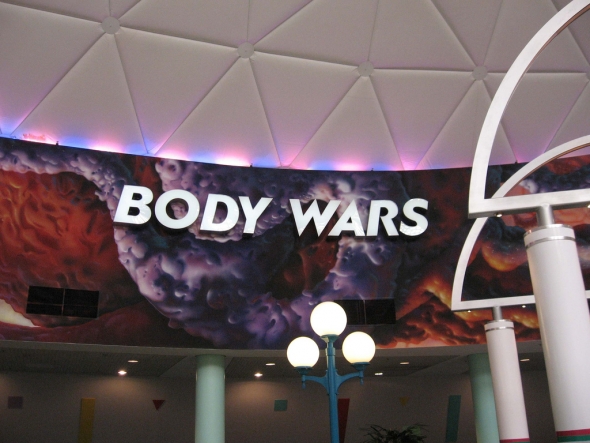Wonders of Life
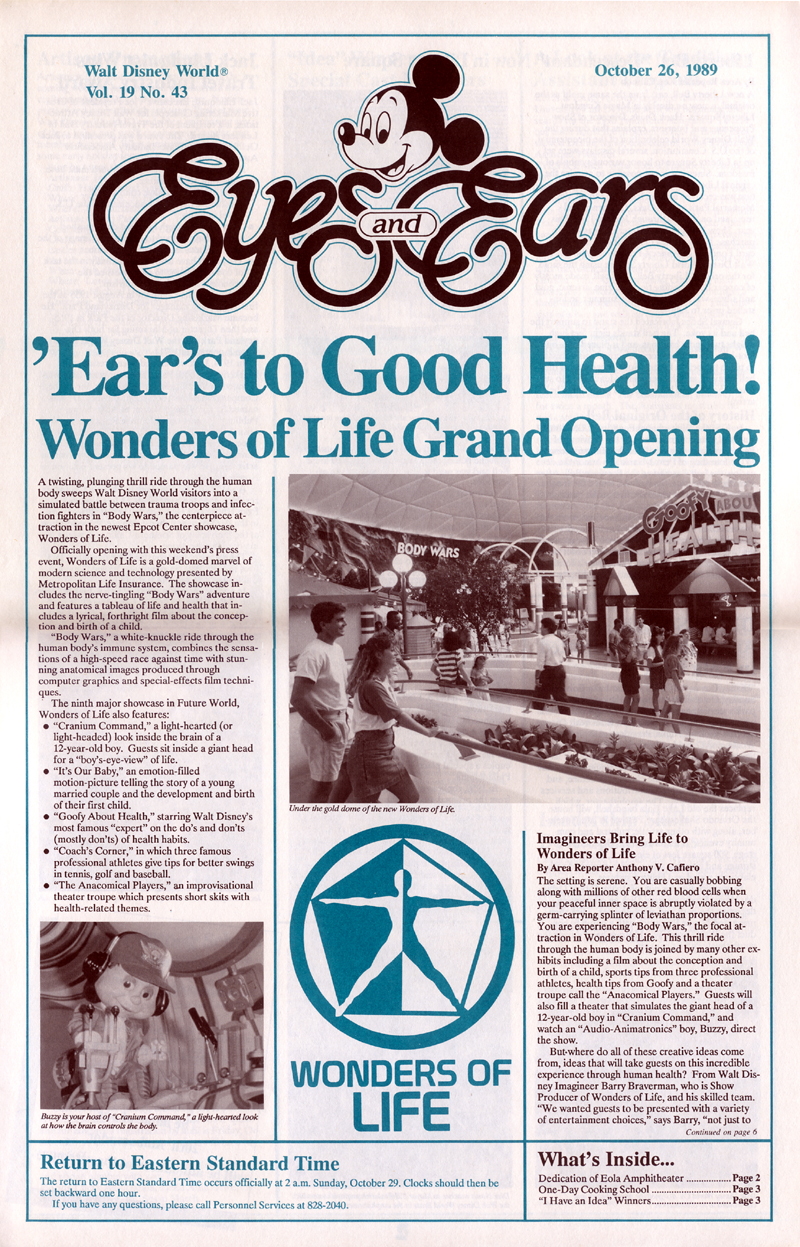
The Wonders of Life pavilion – sponsored by MetLife – opened on October 19, 1989 (seven years after the rest of EPCOT Center, and about five months after the Disney-MGM Studios). Wedged into a small expansion pad between fellow Lost Legends: Universe of Energy and Horizons, it might’ve been easy to miss the park’s new headlining pavilion were it not for the gargantuan, 76-foot tall DNA strand – “The Tower of Life” – marking its entry.

Despite being a 250-foot diameter, 65-foot high golden dome, Wonders of Life was practically understated among the monumental architectural icons of Future World… but what it lacked in grandiosity it more than made up for in its internal aesthetic. Well… if you’re into the heyday of the American shopping mall.
After all, entering the pavilion proper, guests would emerge into the cavernous, 50,000-square-foot interior of Wonders of Life. It’s a geometric place; a circular courtyard contained within a perfectly arcing white interior dome, marked by hexagonal skylights and triangular puzzle patterns that perhaps recall the organic shapes found on the back of your hand at close inspection.
In the center of it all, a 50-foot-wide rotating mobile sculpture would dance among the sunlight (and occasionally, be joined by a remote-controlled blimp floating overhead, bearing MetLife’s mascot, Snoopy.) Absent anything else, the gleaming white interior and the geometric skylights might suggest this is a conference center or a flex space.

But beneath the perpetually white skies resides a midway of pastel, late-’80s treasures. As envisioned in the ’70s, Wonders of Life was a self-contained carnival; a world of carpeted ramps winding down to beige tiled floors; interior planters and cement benches; bold cylinders and stretched canvas; and yes, the funky, pattern-blocked stripes and squiggles and polka dots that made up the primary wardrobe of 1990s Millennials.
This color-blocked, post-modern midway was an open-air ode to the era. It looked and felt different from the other pavilions of Future World, but of course, it was different – born of a different time and purpose. Comparisons to a shopping mall are inevitable… but we’d wager that that would’ve been seen as a high compliment in the design workshops of the era!
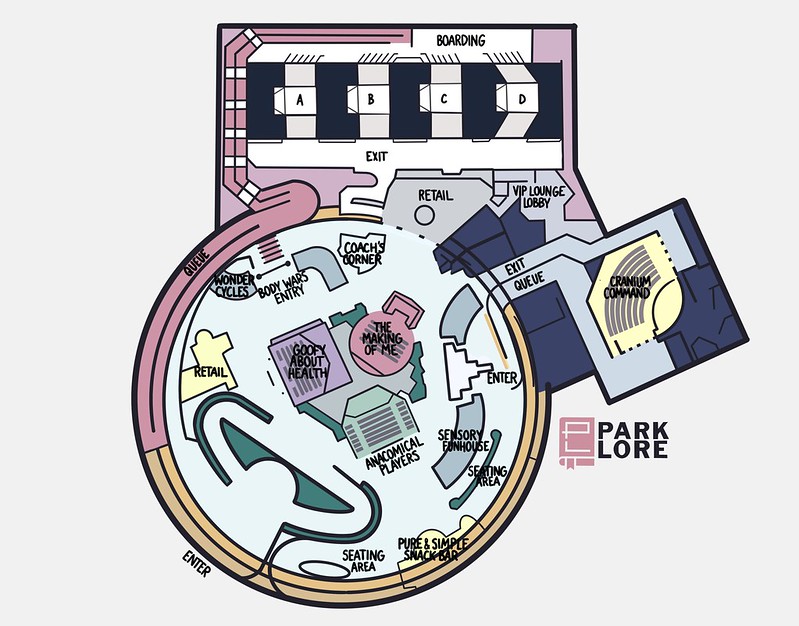
In the pavilions’ center stood three Michael Graves-ian “festival tents,” each housing a “show” of sorts – Goofy About Health (repurposing and remixing old Goofy cartoon shorts’ clips into a continuous montage of heath do’s and don’ts), The Anacomical Players (a pseudo-improv style comedy show, and The Making of Me (an entertaining look at conception and birth starring Martin Short).
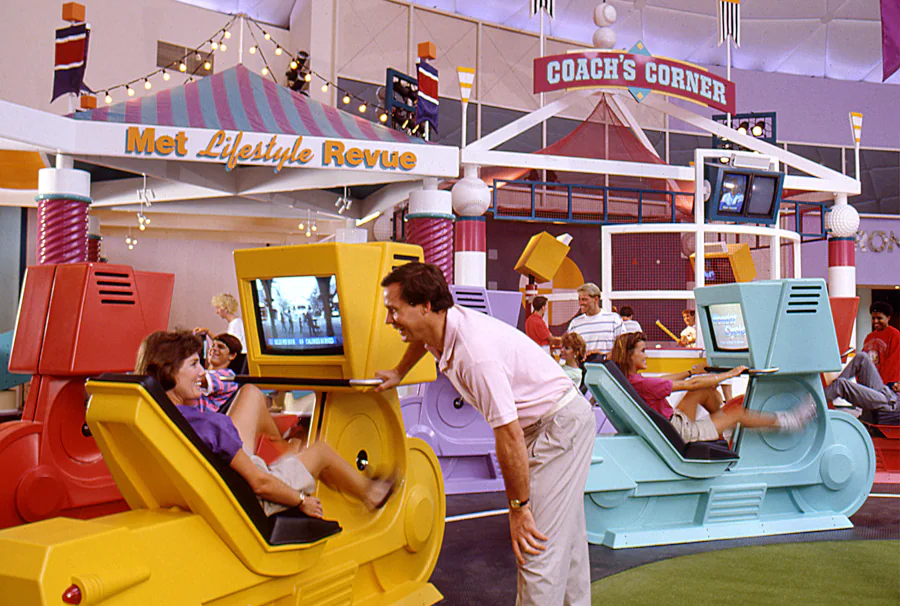
The pavilion also offered the Sensory Funhouse, the Coach’s Corner “training area,” and the iconic WonderCycles – “virtual” fitness bikes that let guests simulate rides through wild environments (including Disneyland) while tracking speed and active calories expended.
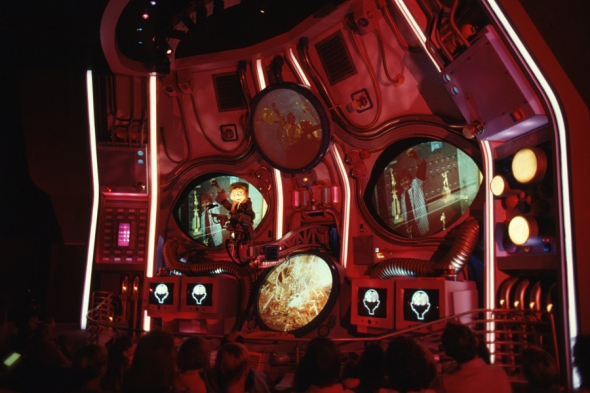
In one of the pavilion’s main shows, guests were drafted to Cranium Command and paired with rookie recruit Buzzy, assigned to control the “lean, mean, thinking machine” of “the most unstable craft in the fleet” – a twelve year old boy named Bobby. Housed inside Bobby’s head, the humorous, 200-seat show introduced a cast of original characters, touching on the emotional ups and downs of puberty.
But just off the midway, the pastel, animated, post-modern aesthetic of Wonders of Life melts away. The wraparound mural that stretches across the pavilion’s rear wall might be enough on its own to ward away those grossed out by what’s to come… It’s a collection of blood vessels, intestinal tubes, and textured tissues (that must be – gulp – something inside of us) adorned with the glowing white, bold words: BODY WARS…
MET Labs
What exactly is Body Wars? To place ourselves in EPCOT in October 1989, it would be difficult to imagine… Even if you’re “tuned in” enough to know that it uses the same ride system as Star Tours, Disney World’s version of that George Lucas ride was still two months from opening (allegedly having been intentionally delayed at MetLife’s request so that Body Wars could premier first). On-ride videos would’ve been practically non-existent and certainly not shareable via the Internet, and the ride’s description – “a high speed thrill ride into the heart of adventure” – wouldn’t exactly help paint the picture.
For us, the best way to understand the hype around EPCOT Center’s new, high tech thrill ride might just be to tackle it head on. The extended queue winds around the cirumference of the pavilion, tucked away in a shadowed alcove dotted with colorful shapes. But once the queue winds away from the pavilion’s dome, its aesthetic quickly transforms.
In a blink, we leave whimsy behind and find ourselves in a strictly-scientific environment; a lab of stark white and silver – something closer to Star Trek than to a fitness fair. On the wall ahead, backlit images captured via a scanning electron microscope display the incredible, almost-alien environments that exist within us: the shimmering orb of the retina; tangled forests of blood vessels; glacial grooves of an iris; the mossy hills of the gut…

We have entered the laboratories of MET – Miniatured Exploration Technologies (and not coincidentally, MetLife). Based on appearances, we’ve stepped into a medical technologies organization of the near-future – a pioneer in health and medicine, dedicated to the betterment of human life. MET’s breakthrough is what brings us here: the incredible LGS-2050 Body Probe. These sleek, white, winged ships can be minitatured to the size of a cell and beamed into the human body for research and exploration. When all is said and done, we’re told, a 26-ton Probe will weigh less than a drop of water.
But today, we’ll be more than just a witness to this newfound technology; we’ll be participants. In the ride’s queue video preshow, we learn that we’re mere minutes behind Dr. Cynthia Lair (played by Academy Award-winning actress Elisabeth Shue), who’s volunteered to be miniaturized and beamed into a patient to study the body’s immune response to a splinter. Our mission is simple: follow Dr. Lair’s route inside the patient aboard Probe Bravo 229 piloted by Captain Braddock (Tim Matheson) to retrieve her and bring her out. Ready for miniaturization?
BODY WARS

Strapped aboard Bravo 229, Captain Braddock appears via a small screen to the right of our viewport. As he welcomes us onboard and signals the start of our reduction sequence, a shield covering the viewport falls away. (It’s important to remember that the ride film you’re about to see is cutting edge, with CGI animation to create the sometimes-startlingly-realistic look and feel of the body. )
We’re pulling up to a particle reducer that’ll beam us just beneath the skin of our patient. As the particle reducer powers up, the vehicle lifts and jostles before being propelled forward (seemingly a re-use of Star Tours’ “lightspeed” maneuver, here beaming us under the skin).
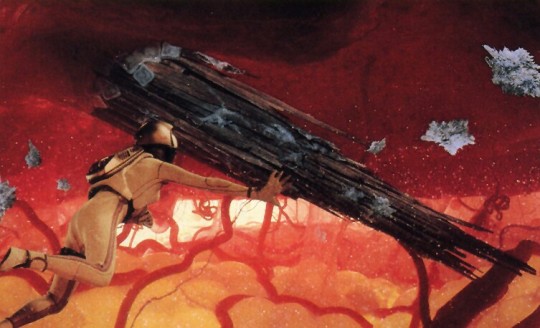
When our view returns, we’re microscopic, drifting in a chamber of twisted vessels and spiraled tubes with oblong spheres drifting past in the channel. “Directly in front of us is a group of white blood cells on their way to destroy the splinter.” As we drift aside to follow them, a continual pulse draws us back and forth, shuffling the pod. Then, it appears – a splinter which, on this scale, might as well be an airplane pierced through the skin with white blood cells clamping on.
Dr. Lair’s here. She needs just one more cell count before she can join us onboard. Our probe slowly drifts around the splinter, weightlessly “floating” on currents the sloshing liquid. But while 1966’s Fantastic Voyage may be a suspenseful, slow-burning race against the clock, Body Wars doesn’t have time for subtlty! Things need to go wrong, and quickly!
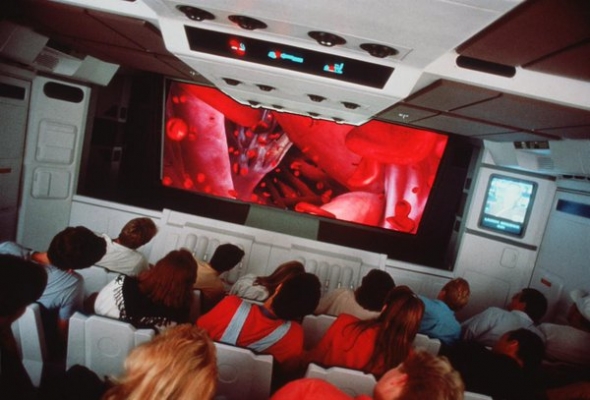
Luckily, as we drift under the splinter, a piece fractures off, drifting away. Out of sight now, Dr. Lair suddenly calls out “Mayday!” Somehow, she’s been pulled into a capillary, and the only way to find her is take off in chase. At once, our probe heaves back and dives, tearing through a bulbous, fatty layer and racing into a vein, slamming left and right amid a sea of surrounding red blood cells.
Sucked through the circulatory system with Dr. Laid directly ahead, the probe manages to gain traction against a vessel wall. Still, the pulse tears the ship forward and back as the tissues around us expand and contract. “I’m being pulled into the heart!” she cries.
The only way to follow Dr. Lair further is through the flaps of the heart’s right ventricle valves. They could crush us if we don’t time it right. The ship heaves back and forth, demonstrating the powerful pulsed tempo. But with Dr. Lair disappearing as she’s drawn further through the circulatory system and toward the lungs, Braddock commands it: “We have to chance it.” The probe blasts through, entering another labyrinthine maze of vessels, pulsing as it’s tossed helplessly along the current.

The probe dives into the wall, reappearing across a permeable membrane in the wide tubes of the airway. As the deep, guttural breaths from the patient surround us, the probe is vehicle floats helplessly through increasingly narrow bronchii, pitching forward and back in nauseating tilts and thrusts.
Then – whoa – with a flash, we’re somewhere else: the fine alveoli of the lungs, where a white blood cell is determined to consume Dr. Lair. Luckily, the probe fires a stun laser, giving Dr. Lair the chance to leap onto the windshield and climb on top of the probe. With our mission successful, it’s time to beam out. Unfortunately, our journey so far as depleted the probe’s energy stores, leaving us stranded in the body.
“We need an energy boost!” Braddock orders.
“The brain! It works on electrical impulse.”
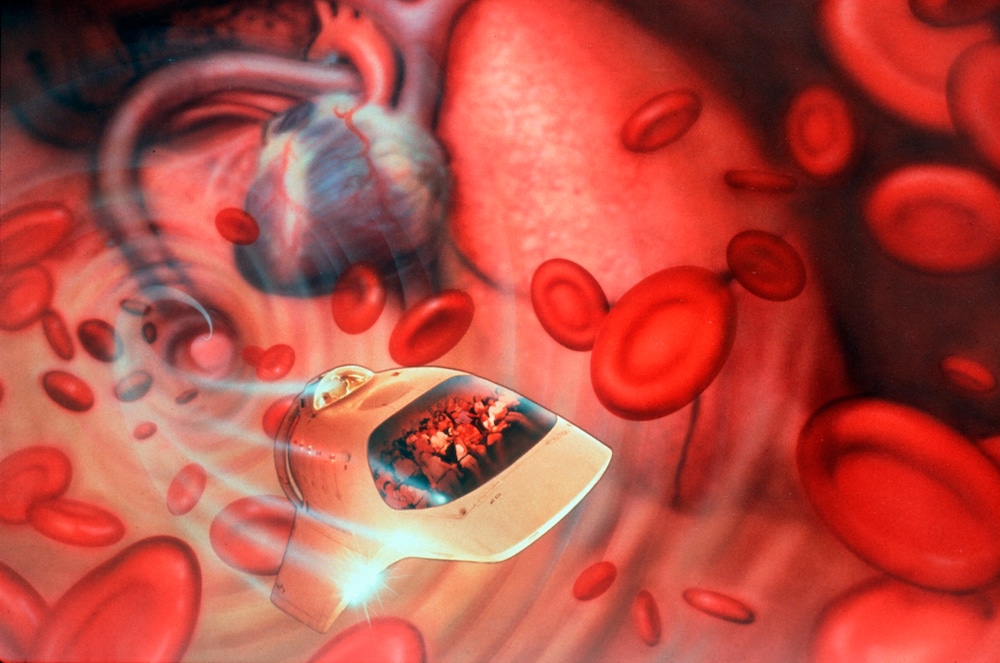
The path forward? Another capillary. This time, we’re drawn backwards into the heart again, slamming and swaying with every pulse. We have only 5% power now. We’ve got to use the heartbeat to propel us! With a pulse, we’re off, slamming again until a hard right takes us into the cavernous meninges, floating just above the brain in a sea of spinal fluid.
With a jolt, we pass the blood-brain barrier and arrive in a microscopic web of electrical threads – the neurons of the brain, their sparks lighting the dark cabin. “The cerebral cortex!” Lair muses. “We’re in the brain!”
“Braddock, your power is gone!” the Mission Commander reports via radio. “I repeat, your power is gone!” With the last bit of strength, the ship drifts helplessly toward a nerve… Our only chance to refuel.
“This neuron better fire…” Then, with a pulse of energy, we enter into the warping beam again, accelerating through a tunnel of light and energy. In a flash, we’re back outside the particle reducer. “Incredible!” Lair celebrates. “Do you realize what we just did?!”
“You broke every regulation in the book! You also managed to pull off the most spectacular mission this place has ever seen! Congratulations.”
We always include a point-of-view video in our Lost Legends entries to give you a first-person perspective of what it was like to experience these forgotten attractions. The video below will give you the full Body Wars experience including its queue and pre-shows; the ride itself begins at 12:45. Watch here:
And just like that, your mission is complete. You’ll pass down a series of simple, laboratory hallways before the pastel midway of Wonders of Life comes back into view. Sure, Body Wars might not have the stellar, emotional story of some of Disney’s best, and it’s a little more light on content than many of Epcot’s storied dark rides. But it was one hell of a ride. The question is, would you ride it again?
And for that matter, did you notice in that video that the videographer rode alone? On the next page, we’ll dissect the issues that might’ve meant Body Wars’ time was short from the start…



